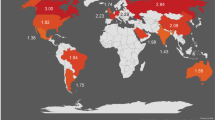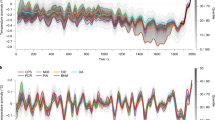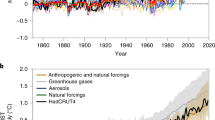Abstract
The Earth’s energy balance is key to understanding climate and climate variations that are caused by natural and anthropogenic changes in the atmospheric composition. Despite abundant observational evidence for changes in the energy balance over the past decades1,2,3, the formal detection of climate warming and its attribution to human influence has so far relied mostly on the difference between spatio-temporal warming patterns of natural and anthropogenic origin4,5,6. Here we present an alternative attribution method that relies on the principle of conservation of energy, without assumptions about spatial warming patterns. Based on a massive ensemble of simulations with an intermediate-complexity climate model we demonstrate that known changes in the global energy balance and in radiative forcing tightly constrain the magnitude of anthropogenic warming. We find that since the mid-twentieth century, greenhouse gases contributed 0.85 °C of warming (5–95% uncertainty: 0.6–1.1 °C), about half of which was offset by the cooling effects of aerosols, with a total observed change in global temperature of about 0.56 °C. The observed trends are extremely unlikely (<5%) to be caused by internal variability, even if current models were found to strongly underestimate it. Our method is complementary to optimal fingerprinting attribution and produces fully consistent results, thus suggesting an even higher confidence that human-induced causes dominate the observed warming.
This is a preview of subscription content, access via your institution
Access options
Subscribe to this journal
Receive 12 print issues and online access
$259.00 per year
only $21.58 per issue
Buy this article
- Purchase on Springer Link
- Instant access to full article PDF
Prices may be subject to local taxes which are calculated during checkout




Similar content being viewed by others
References
Trenberth, K. E., Fasullo, J. T. & Kiehl, J. Earth’s global energy budget. Bull. Am. Meteorol. Soc. 90, 311–323 (2009).
Murphy, D. M. et al. An observationally based energy balance for the Earth since 1950. J. Geophys. Res. 114, D17107 (2009).
Domingues, C. M. et al. Improved estimates of upper-ocean warming and multi-decadal sea-level rise. Nature 453, 1090–1093 (2008).
Hegerl, G. C. et al. in IPCC Climate Change 2007: The Physical Science Basis (eds Solomon, S. et al.) (Cambridge Univ. Press, 2007).
Tett, S. F. B., Stott, P. A., Allen, M. R., Ingram, W. J. & Mitchell, J. F. B. Causes of twentieth-century temperature change near the Earth’s surface. Nature 399, 569–572 (1999).
Stott, P. A. et al. Attribution of twentieth century temperature change to natural and anthropogenic causes. Clim. Dyn. 17, 1–21 (2001).
Barnett, T. et al. Detecting and attributing external influences on the climate system: A review of recent advances. J. Clim. 18, 1291–1314 (2005).
Solomon, S. et al. in IPCC Climate Change 2007: The Physical Science Basis (eds Solomon, S. et al.) (Cambridge Univ. Press, 2007).
Levitus, S., Antonov, J. & Boyer, T. Warming of the world ocean, 1955–2003. Geophys. Res. Lett. 32, L02604 (2005).
Lyman, J. M. et al. Robust warming of the global upper ocean. Nature 465, 334–337 (2010).
Knutti, R. & Hegerl, G. C. The equilibrium sensitivity of the Earth’s temperature to radiation changes. Nature Geosci. 1, 735–743 (2008).
Stocker, T. F., Wright, D. G. & Mysak, L. A. A zonally averaged, coupled ocean atmosphere model for paleoclimate studies. J. Clim. 5, 773–797 (1992).
Knutti, R., Stocker, T. F., Joos, F. & Plattner, G. K. Constraints on radiative forcing and future climate change from observations and climate model ensembles. Nature 416, 719–723 (2002).
Nakicenovic, N. & Swart, R. Special Report on Emissions Scenarios. A Special Report of Working Group III of the Intergovernmental Panel on Climate Change (2000).
Joos, F. et al. Global warming feedbacks on terrestrial carbon uptake under the Intergovernmental Panel on Climate Change (IPCC) emission scenarios. Glob. Biogeochem. Cycles 15, 891–907 (2001).
Crowley, T. J. Causes of climate change over the past 1000 years. Science 289, 270–277 (2000).
Huber, M. B. The Earth’s Energy Balance and its Changes: Implications for Past and Future Temperature Change http://dx.doi.org/10.3929/ethz-a-006689560 (ETH, 2011).
Baringer, M. O., Arndt, D. S. & Johnson, M. R. State of the Climate in 2009. Bull. Am. Meteorol. Soc. 91, S1–S224 (2010).
Hansen, J. et al. Efficacy of climate forcings. J. Geophys. Res. 110, D18104 (2005).
Stone, D. A., Allen, M. R., Selten, F., Kliphuis, M. & Stott, P. A. The detection and attribution of climate change using an ensemble of opportunity. J. Clim. 20, 504–516 (2007).
Meinshausen, M. et al. Greenhouse-gas emission targets for limiting global warming to 2 °C. Nature 458, 1158–1162 (2009).
Solomon, S., Plattner, G. K., Knutti, R. & Friedlingstein, P. Irreversible climate change due to carbon dioxide emissions. Proc. Natl Acad. Sci. USA 106, 1704–1709 (2009).
Meehl, G. A., Covey, C., McAvaney, B., Latif, M. & Stouffer, R. J. Overview of the coupled model intercomparison project. Bull. Am. Meteorol. Soc. 86, 89–93 (2005).
Hegerl, G. C., Crowley, T. J., Hyde, W. T. & Frame, D. J. Climate sensitivity constrained by temperature reconstructions over the past seven centuries. Nature 440, 1029–1032 (2006).
Schmittner, A. & Stocker, T. F. The stability of the thermohaline circulation in global warming experiments. J. Clim. 12, 1117–1133 (1999).
Knutti, R., Stocker, T. F., Joos, F. & Plattner, G. K. Probabilistic climate change projections using neural networks. Clim. Dyn. 21, 257–272 (2003).
Levitus, S. et al. Global ocean heat content 1955–2008 in light of recently revealed instrumentation problems. Geophys. Res. Lett. 36, L07608 (2009).
Ishii, M. & Kimoto, M. Reevaluation of historical ocean heat content variations with time-varying XBT and MBT depth bias corrections. J. Oceanogr. 65, 287–299 (2009).
Palmer, M. D., Haines, K., Tett, S. F. B. & Ansell, T. J. Isolating the signal of ocean global warming. Geophys. Res. Lett. 34, L23610 (2007).
Acknowledgements
We thank Urs Beyerle for the technical support of the climate model. Support for the International Detection and Attribution Working Group (IDAG) by the US Department of Energy’s Office of Science, Office of Biological and Environmental Research grant DE-SC0004956 and the National Oceanic and Atmospheric Administration’s Climate Program Office is acknowledged.
Author information
Authors and Affiliations
Contributions
M.H. performed the climate model computations and statistical analysis. Both authors designed the study and wrote the paper.
Corresponding author
Ethics declarations
Competing interests
The authors declare no competing financial interests.
Supplementary information
Supplementary Information
Supplementary Information (PDF 570 kb)
Rights and permissions
About this article
Cite this article
Huber, M., Knutti, R. Anthropogenic and natural warming inferred from changes in Earth’s energy balance. Nature Geosci 5, 31–36 (2012). https://doi.org/10.1038/ngeo1327
Received:
Accepted:
Published:
Issue Date:
DOI: https://doi.org/10.1038/ngeo1327
This article is cited by
-
Potential alternatives for Norway spruce wood: a selection based on defect-free wood properties
Annals of Forest Science (2023)
-
The performance of CMIP6 models in simulating surface energy fluxes over global continents
Climate Dynamics (2023)
-
Investigating the variation pattern and erosivity power of precipitation in the Sindh river basin of India during last 120 years
Stochastic Environmental Research and Risk Assessment (2022)
-
Best Combinations of Inputs for ANN-Based Solar Radiation Forecasting in Morocco
Technology and Economics of Smart Grids and Sustainable Energy (2022)
-
Towards neural Earth system modelling by integrating artificial intelligence in Earth system science
Nature Machine Intelligence (2021)



